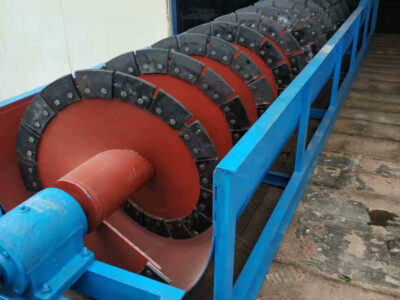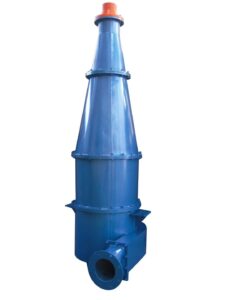In the medium (water or air), the material is divided into several particle size levels according to the different settling speeds, called classification. The purpose of classification and screening is the same: dividing the ore particle group into various particle sizes.
1. What is the significance of classifying in the grinding?
Classifying plays a very important role in the grinding process. Because the valuable minerals embedded in fine grains and gangue are to be dissociated and sorted, it must grind the ore to a certain fineness. However, it is necessary to avoid over-grinding and prevent the adverse effect of sludge on the sorting process. It requires that the part of the grinding ore with suitable particle size be separated in time to avoid unnecessary grinding and sent to the sorting operation as soon as possible. It should split the particle size. Unqualified items are returned to the mill for regrinding.
It can see that the closed-circuit grinding cycle with grading operation is of great significance both technically and economically. At present, it widely uses grading operations in the production of concentrators.
2. What is the classification process and principle?
The process of dividing mixed materials with different particle sizes into several levels in water according to their different sedimentation rates is called hydraulic classification.
If ore particles with the same specific gravity, the sedimentation speed of large particle size is fast, and that of small particle size is slow. Therefore, it can accord the sedimentation of ore particles to divide the different particle sizes.
According to the different settling speeds of the material in the liquid medium, the machine that divides the material into several grades is called a classifier. The settled coarse-grained part is called grit, which is discharged by a mechanical device (screw or rake), and the suspended fine-grained part is called overflow, which is discharged by water flow.
3. How many types of mechanical classifiers are there? Which is commonly used?
According to its structural characteristics, it can be divided into three types: spiral classifier, rake classifier, and suspension tank classifier.
Among the three types of mechanical classifiers, the latter two types have been gradually eliminated in production plants and mines and can only see in individual old dressing plants.
4. What classification equipment is commonly used in concentrators?
- Spiral classifier

This kind of classifier is classified according to the difference in settling speed of ore particles of different sizes in the aqueous medium. Because of its simple structure, stable work, and convenient operation, it has been widely used in concentrators. The spiral classifier is divided into high weir type, submerged type, and low weir type according to the position of the spiral in the water tank and the height of the overflow surface. The high weir type is suitable for separating the overflow larger than the particle size, so it is mostly used for the first stage grinding. In contrast, the submerged type is ideal for separating the products smaller than the particle size and is mainly used in the second stage of grinding to form a closed circuit with the mill. - Hydrocyclone

- Fine screen
Since the spiral classifier and the hydrocyclone are classified according to the settling speed of the ore particles in the water medium, it is easy to produce the reverse enrichment of the valuable minerals in the settling sand, resulting in the crushing of the valuable minerals. The fine screen is classified according to the geometric size of ore particles, which is hardly affected by the density and has high classification efficiency. Therefore, in recent years, the fine screen as classification equipment in the grinding cycle has been paid more and more attention.
5. How many types of spiral classifiers are there? What’s the difference?
According to the position of the spiral in the groove and the height of the pulp surface, there are three types: low weir type, high weir type, and submerged type.
The difference is:
Low Weir: The overflow weir is below the helix axis of the helix. Due to the small settlement area, this classifier is only used for washing sand ores with little mud and dewatering coarse gifts in actual production and is rarely used in grinding cycles.
High Weir: The overflow weir is higher than the axis of rotation of the spiral but lower than the upper edge of the spiral at the overflow end. This kind of classifier has a lower settlement area and a larger weir type and can adjust its weir height within a specific range. That is, the scope of the settlement area can be modified and changed within a particular field to adjust the particle size of classification. It’s a commonly used device.
Submerged type – there are 4-5 spiral blades at the end of the overflow weir, all submerged in the pulp. This kind of classifier has a larger settlement area and a deep classification pool, and the agitation of the spiral has little effect on the surface of the pulp. Therefore, the grading surface is stable, and the overflow is large and fine. It is often used as classification equipment for fine grinding or two-stage grinding in the production of dressing plants.
If you are finding classification equipment, please feel free to contact us. We are a professional mining equipment manufacturer in China.

